


The iconic Gothic cathedral, some great works of art, a terrific castle and a couple of fabulous early Christian and Romanesque churches.


By train from Basel in March 2014 for a weekend in Milan. Rather a last minute trip so no chance to see Leonardo da Vinci's Last Supper.
We arrived late morning on the Saturday and headed straight for lunch near our hotel (not the best meal we've had in Italy at Scorpion Bar and Restaurant - very average food and overpriced) then on the the beautiful cathedral on Piazza del Duomo. We discovered that it was carnival time so the city was packed!




The Duomo took almost 500 years to complete, the finishing touches being made in 1813. Nevertheless, the west facade is a very fine Gothic extravaganza.


The bronze doors are also worth a look - not the impressive main doors with the life of the Virgin Mary but rather some side doors with an array of military exploits in bronze relief.
Though beautiful on the outside, the interior is rather gloomy. The sixteenth century statue of the flayed San Bartolomeo, his skin thrown nonchalantly over his shoulder, is a study in anatomy at a time when it was frowned upon by the Catholic church.


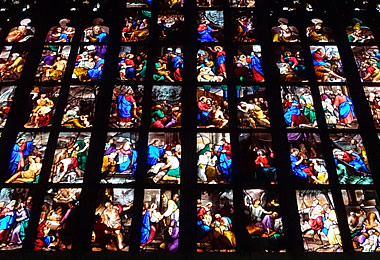





An eighteenth century sundial is embedded into the lovely marble floor. A beam of light falls on the sun dial through a hole in the ceiling but it is no longer accurate due to the change in the tilt of the earth's axis.
And there is some very fine stained glass.
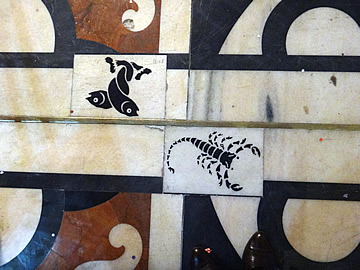





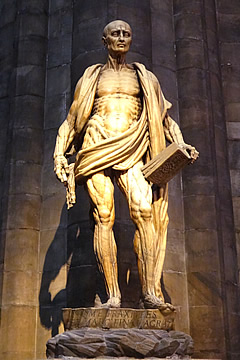
We went up the tower in a lift and out onto the roof of the Duomo. Here you see the intricate stone pinnacles and tracery of the Gothic decoration up close, a very impressive sight. From the piazza you get an overall impression but it is really worth getting up to the roof to appreciate the sheer scale and intricacy of the work.
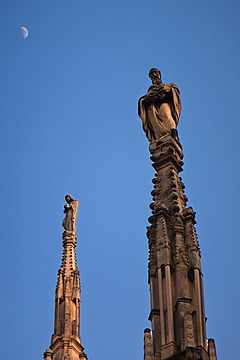
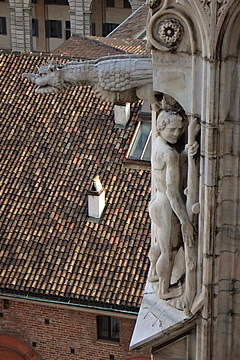
The Piazza del Duomo also has the high arched entrance to the Galleria Vittorio Emanuele II, a huge cruciform shopping arcade on four levels dating from the nineteenth century. We're not keen shoppers but did stroll through the impressive space and even had a very good pizza, though poor cream-encrusted desserts, in Ristorante Galleria before catching our train home on the Monday.

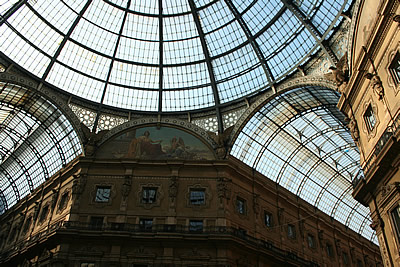



Through the north arm of the Galleria brings you to Piazza della Scala where the world famous La Scala opera house stands. In the centre is a statue of Leonardo da Vinci.

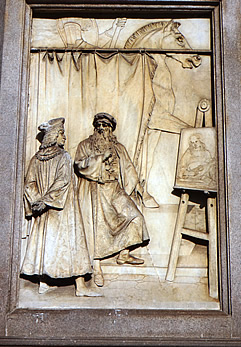
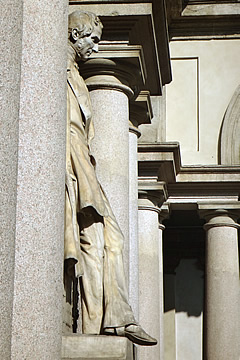
The Pinacoteca di Brera is Milan's finest art gallery, north of Piazza della Scala. We visited mainly to see the lovely Piero della Francesca, the one I always call The Egg, but which is actually titled La Pala Montefeltro - The Montefeltro Altarpiece. Piero was one of the earliest masters of perspective painting and this work is a demonstration of his skill at its finest.
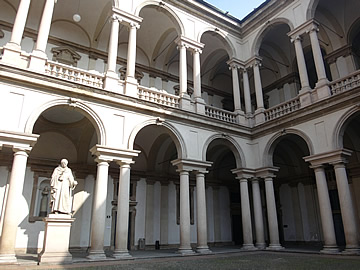

The piece was commissioned by Federico da Montefeltro, Duke of Urbino, who appears in armour kneeling on the right of the painting, perhaps on the birth of his son, Guidobaldo.
The egg, suspended above the Madonna with the sleeping Christ Child on her lap, is a symbol of fertility and birth. It is also an heraldic symbol of the Montefeltro family.1



Like many great galleries with huge numbers of outstanding works of art, the Brera provides a "must see" guide to their very best, including Mantegna, Caravaggio (another of my favourites), Bellini, Rafaello, and of course Piero della Francesca. Caravaggio's Supper at Emmaus was out on loan.

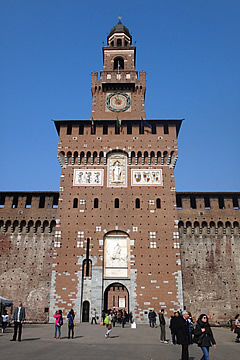



Not too far away to the west is the red brick Castello Sforzesco.4 The first castle, built by the ruling Visconti family on this site, was destroyed in 1447 but was rebuilt by the Sforza family. It is now home to a number of museums.

The castle underwent a major restoration at the end of the nineteenth century to recreate the towers and battlements as they had been conceived centuries earlier.
We enjoyed visiting the castle just for itself as much as for anything we saw inside. Really excellent information sheets are provided.

There are some lovely primitive Romanesque carvings originally on the twelfth century Porta Romana on the south side of the city. Friezes depict the return of the Milanese to their city from 1167 after it had been destroyed by Barbarossa and his allies in 1160 and all the inhabitants sent into exile.
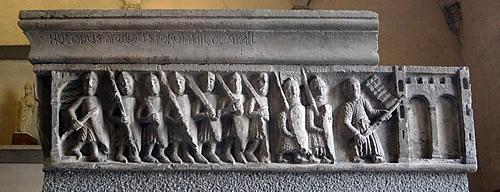

Michelangelo worked on the Rondanini Pietà in the last nine years of his life. Still unfinished it is obviously a piece that the sculptor had some difficulty with, changing the position of the arms, legs and heads, elongating the figures. It didn't appeal to me, it has none of the raw power of the unfinished series of Slaves in the Accademia in Florence for instance, but its subject is quite different - mother and child, mortality - and at the end of his life it probably had a great resonance with the sculptor himself.





We had an excellent lunch at Trattoria Torre di Pisa: spaghetti Carbonara, Ravioli, carafe of red, biscotti vin santo and coffee for 52 Euros - very good value.
Basilica di Sant'Ambrogio was founded in the fourth century by Milan's patron saint and his most famous convert, Saint Augustine, heard him preach in the original church which no longer exists.
The Romanesque church which stands there today, however, is lovely.








The Sarcophagus of Stilichone is some 1600 years old and is covered with wonderful biblical carving.5
The twelfth century pulpit is also very finely carved with reliefs based on the writings of St Ambrose focussing on sin and redemption.



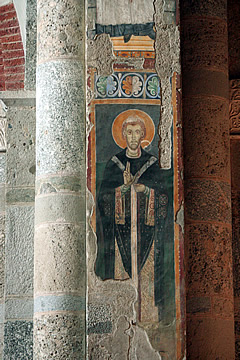





Nearby is the restored Pusteria di Sant'Ambrogio, one of the medieval posterns - a postern is a lesser gate to a city. Above the gate are small statues of Saint Ambrose and saints Gervase and Protase. These latter saints were martyred Roman soldiers whose bodies lie with that of St Ambrose in the crypt of the church.

A couple of the restored medieval gates - Porta Nuova and Porta Ticinese - can also be seen. During restoration some ancient Roman stelae were inserted into the walls of Porta Nuova north east of the centre.
South of the centre fourteen Roman Corinthian columns stand next to Porta Ticinese and the Basilica of San Lorenzo.
 The tower and arches of medieval Porta Ticinese near the Roman columns.
The tower and arches of medieval Porta Ticinese near the Roman columns. Not much of Roman times remains in Milan, though it was at one time the seat of the Western Roman Empire and it was from here that the Emperor Constantine issued the Edict of Milan in 313AD, granting Christians for the first time the right to worship in the Empire.
It is said that Leonardo da Vinci considered the Basilica di San Lorenzo to be the most beautiful in Milan.It was built during Roman times in the fourth century, but has been rebuilt and renovated several times since then.





Inside the church the Cappella di Sant'Aquilino is famous for its fifth century mosaics. Entrance was 2 euros but that's well worth it, especially as the ticket has a lot of information on the reverse.
The fifth century chapel was originally a small church in its own right, dedicated to St. Genesio. It is entered through an atrium with the remains of frescoes and a fragment of beautiful blue mosaic.
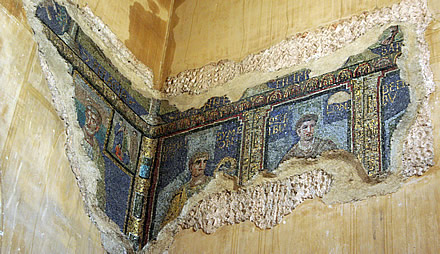




There are two mosaics in the chapel, Christ with the Apostles is in excellent condition but the other is very badly damaged, the complete central section gone leaving only a scene with shepherds and sheep.

From the chapel there are stairs leading down to the original foundations of the church, the blocks of stone scavenged from the nearby Roman amphitheatre.6